
views
Preparing to Detangle

Calm yourself and make sure you have time to devote to detangling. Trying to rush through the process will likely worsen the knot and leave you angry and frustrated. Working out a knot can take time and a lot of patience, and you should go into the process as calmly as possible. Take a few deep breaths, put on some enjoyable music, and get to work. If you have a friend, sibling, or parent willing to help, you can speed up the process. And if the knot is somewhere that is difficult to reach, they may be necessary. Remember to take breaks. You may need to stop and rest your arms. If you don't have time to deal with the knot, pull your hair into a bun and wait until you have enough time to dedicate to working it out.
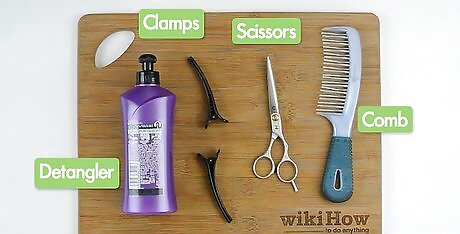
Gather your materials. When trying to unknot hair, your tools can make all the difference. You absolutely want to use a detangler, conditioner, or other lubricant (like coconut oil). Don't use a brush, as this can lead to more knotting. Instead, find a sturdy medium- or wide-toothed comb. Set up a chair in front of a mirror--you'll want to be sitting, since it may take a while. There's an abundance of detangling products for curly-haired people. Look for sprays to use after the shower, plus rinses and shampoos that can help when you wash your hair. Look for gentle, no-tears versions for kids or very fine hair. If your hair is dry and damaged, look for a product that moisturizes as it detangles. You can also use a silicone-based de-frizzing gel to work out tangles. Make your own spray by mixing conditioner and water in a clean, empty spray bottle.

Detangle your hair when it's dry to avoid breakage. Some experts will recommend detangling your hair when it's wet because it's more stretchy and elastic. However, detangling wet hair can actually lead to more breakage, so it's best to work on it when it's dry. If you need to, lightly mist your hair with spray or conditioner to add lubrication and "slip" to dry hair, which is often sufficient for working out a knot. Some experts recommend detangling right before you shower, so you can easily work shampoo and conditioner through your hair and comb it out afterwards.
Working out the Knot
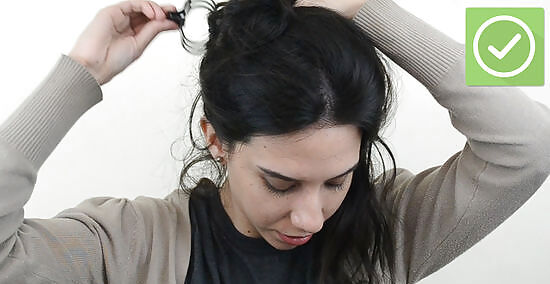
Divide your hair to isolate the knot. Use plastic hair clamps or clips to separate your hair. Try to clip back all the hair that is not already part of the knot so it doesn't end up in the mess. The knot should be free from the clips with everything else pulled out of the way. If you have a ton of tangles, it will be much easier for you to work in sections. Try dividing your hair into about six sections and work on them one at a time. If you're working through all your hair, make sure you separate the finished sections from those that are still knotted. You may want to braid the finished section so it doesn't tangle again.
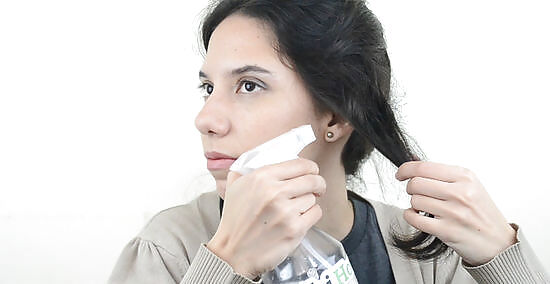
Mist the section of hair with your detangler. Apply the product and allow it to sit for several minutes so it can soak into your hair. Follow the instructions on the bottle of the product. The more slip and lubrication, the easier it will be to undo the knot.
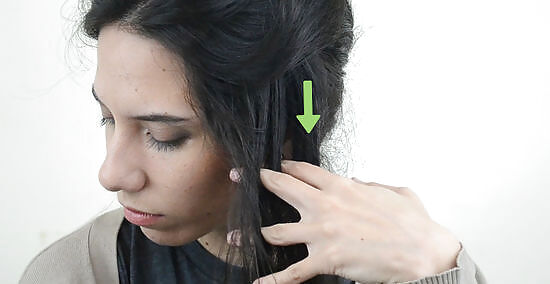
Work the product into the knot with your fingers. Begin close to the bottom of your hair and gently massage the detangler into the knot. This will help add slip, making it easier to detangle your hair with the comb. Feeling the knot with your hands can give you a better idea of what you're working against, like the size and how tightly the strands are knotted.

Pick the tail of a rat-tail comb into the center of the knot. Gently wiggle the comb back and forth to help loosen the knot. Don't tug on your hair with the comb—that will lead to breakage, which will only create future tangles. Be very, very gentle when combing through the knot If you can't get the comb through the knot, try applying more product. Remember to take breaks if you get tired or frustrated. This process may take quite a while.
Work your way up the section of hair, through the knot. When you are able to comb easily through your hair, move up the strand a little and gently pull the comb downwards, applying product as needed. Make sure you are holding your hair firmly with your free hand, near the root. This will make the tugging less painful and can help prevent breakage. If you can't move the comb smoothly through your hair without hitting snags or tearing your hair, move upwards in smaller increments.
Remove tiny knots with your fingers if possible. Even when you've successfully removed the knot from your hair, you may find a few tiny knots that are extremely tight. Try picking them out with the tail of your comb, just like you did with the bigger knot. If they won't budge, stop and try a different strand of hair. If you have removed some hair from the tiny knot but it still won't undo, see a salon professional. Never rip the knot out with a comb.
Preventing Future Knots and Tangles

Braid or pineapple your hair before going to sleep. Gently gathering your hair in a braid or pineapple updo will keep you from sleeping directly on top of it, decreasing friction. You can also try a sleeping bonnet, satin or silk pillowcase or a hair net to keep your hair tangle-free at night. Use soft hair ties, not rubber bands, to pull your hair back. Remove any bobby pins you may have used to style your hair.
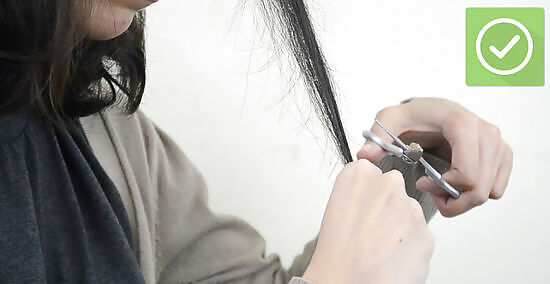
Trim your hair regularly. Many women can't stand to give up even a centimeter of their hard-earned hair length, but avoiding haircuts leads to dead, dry hair and split ends that cause tangles. At the very least, you should get your hair trimmed every three months, and tell your stylist you want the dead hair removed. Split ends can travel up the hair shaft, damaging living hair and causing major tangles. As much as you may love every inch of your hair, dry, dead hair really doesn't look very good. Remember that your hair will continue to grow, and it will look healthier and stronger if you get a minor cut every season.

Wash your hair like you're in a shampoo commercial. Don't pile your hair on top of your head and scrub like crazy. Picture the way women shampoo their hair in commercials: focus on the scalp, massaging with your fingers, and allow the product to rinse through your hair.

Avoid necklaces with fine chains and shirts with collars if you have long hair. Very long hair is prone to tangling, and can easily snag on the fine chain of a delicate necklace or an elaborate collar on your blouse. If you don't want to give up your necklaces, make sure the chain stays under the collar of your shirt, and try not to wear more than one. Check necklaces and collars often to make sure they aren't catching your hair and forming a knot.














Comments
0 comment